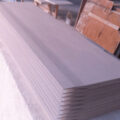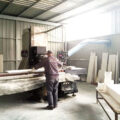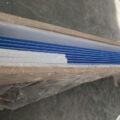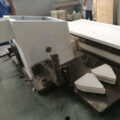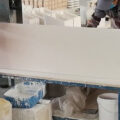Generally, the continuous casting process of molten aluminum is performed in a commercial-scale operation. The continuous caster process usually includes a pair of rotating water-cooled caster rolls, in which the molten metal enters the rotating caster roll through the feed tip nozzle just before the production line closest to the caster roll. By contacting the water-cooled continuous casting roll, heat is quickly extracted from the molten metal, and the molten metal freezes when it comes into contact with the water-cooled continuous casting roll. The solid metal is compressed as it passes through the gap between the continuous casting rolls, and the thickness of the emerging metal is determined by the narrowest spacing between the continuous casting rolls. The thin metal sheet comes out of the continuous caster roll, and its width is a few meters and the thickness is about one to six millimeters (depending on the actual distance between the caster rolls). The speed of the casting process is about 1-4 meters per minute, and each run can last for several days.
An important part of the casting process is the feed nozzle, which delivers the molten metal directly into the gap between the two continuous casting rolls. This process usually places the top and bottom surfaces of the feed nozzle in direct contact with the caster roller. Generally, the feed tip nozzle is made of a harder and more corrosive material than the steel caster material, such as alumina or alumina-silica fiber. The interaction between the movable continuous casting roll and the hard feed tip nozzle can cause the embedding of scratches into the softer casters.
After the metal has solidified, when the metal passes and is compressed to conform to the thickness defined by the narrowest gap between the casting rolls, these scratches embedded in the casting rolls are again applied to the metal. The end result is the production of a continuous metal sheet with scratches, which is usually represented by raised ridges that extend above the expected thickness of the metal sheet, which is determined by the narrowest gap between the casters determine.
Currently, the only way to eliminate the scratches transferred to the metal plate during the die casting process is to use a feed nozzle with little or no bend. It can resist the absorption of water; and has the heat and strength characteristics required to successfully cast non-ferrous metals.
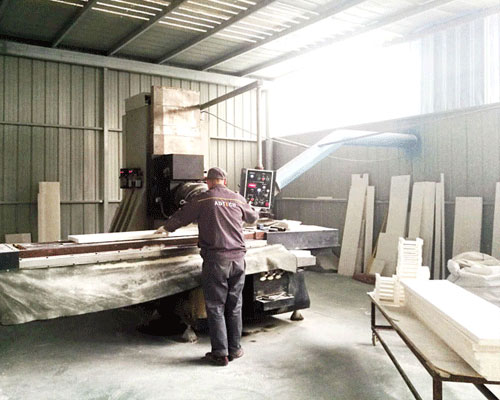
AdTech casting tips and nozzle plate introduces the cushion into the continuous casting process and also reduces the direct friction between the feed nozzle and the pair of casting rolls. Cushion pads are attached to the top and bottom sides of the feed nozzle, adjacent to the caster roller, successfully preventing scratches from being embedded in the caster roller. This addition extends the service life of the feed nozzle and a pair of caster rollers.
The feed nozzle for a continuous casting machine has a cushion, which includes a layer of ceramic fibers sandwiched between the top and bottom layers of a glass fiber cloth. The material used for the cushion is softer than the material used to produce the feed head. It can withstand temperatures higher than 260°C (500°F); and is durable enough to maintain its original consistency during continuous operation of the continuous caster. The purpose of the cushion is to act as a medium to protect and prevent aggressive feed tip nozzles from contacting the twin caster rolls during and before continuous casting operations.


